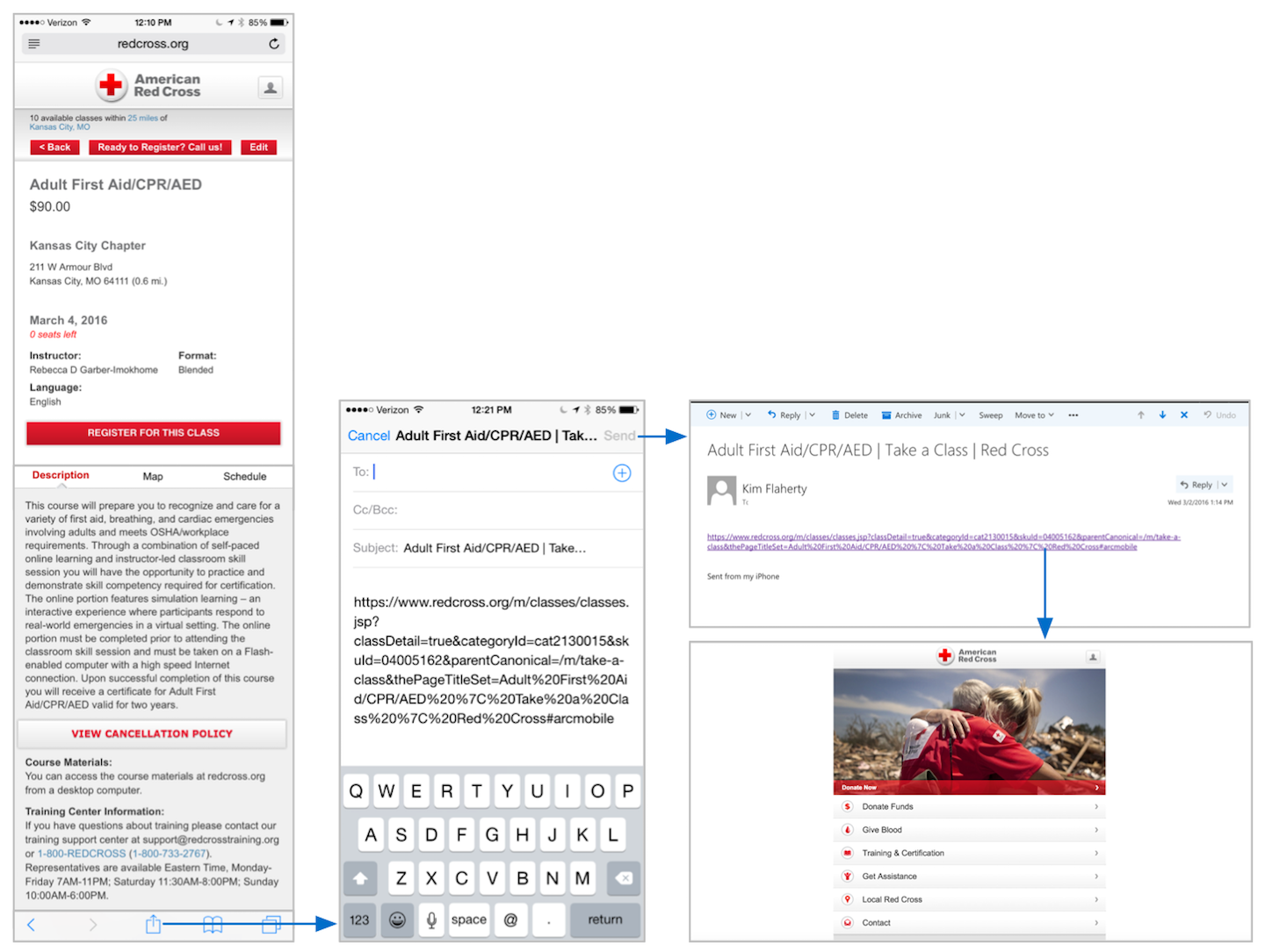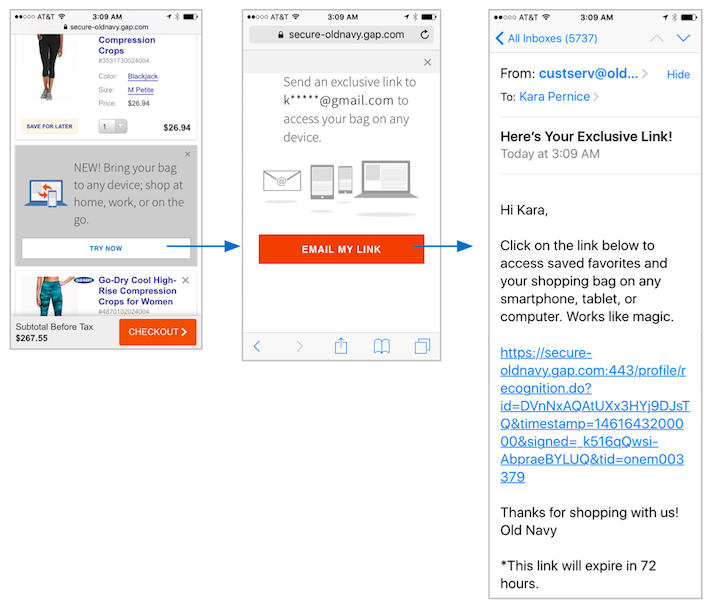Last weekend I flew out of town for a quick get-together with friends. On my way home I started to think how differently I fly these days. Not that long ago my air-travel experience involved the steps in the leftmost column in the table below.
|
Before |
Now |
Stage in the process |
|---|---|---|
|
I’d book my flight online on my laptop weeks or months in advance. |
At home |
|
|
When travel day approached I go through my email folders searching for the flight info and confirmation email. |
The airline app sends me a push notification the day before my flight prompting me to check in, so I no longer fumble through my email searching for a confirmation number. |
At home: check-in |
|
I log into the website, enter my confirmation number, check in, and print out my boarding pass. |
When I check in, I get several options for how I’d like to receive my boarding pass, depending on my needs. I choose to save it directly to my phone for easy access later. |
At home: check-in |
|
At the airport, I’d wait in line to check my bag. |
Baggage lines are shorter because I can now print my own baggage ticket at a kiosk by scanning the boarding pass from my phone, which is easily accessible with the swipe of a finger. |
At the airport: baggage drop |
|
Then I’d have to wait in line again for security while frantically searching for the printed boarding pass (often misplaced by this point). |
The digital boarding pass on my phone or smartwatch allows me to get through security without dealing with paper tickets. |
At the airport: security |
|
Finally, I’d prepare to board the plane – again while frantically searching for my boarding pass (which had been shoved somewhere in my travel gear). |
I show my phone/smartwatch to the gate agent to board. |
At the gate: boarding |
|
I periodically check airport monitors and listen to announcements to make sure that my flight status hasn’t changed. |
If there’s a flight-status change, I’m updated immediately by text message or email. |
At the airport (or at home) |
|
I have to watch a preselected movie on a monitor available to half the coach area. |
When I’m finally on the plane, I can visit the airline website to watch movies and TV shows from any of my devices during the flight. |
On the plane |
A comparison of two different travel experiences (A more effective way to visualize these journeys is customer-journey mapping — a tool for effectively understanding and communicating such customer journeys within an organization.)
Nowadays, air travel is a lot more streamlined and enjoyable. When I am away from my computer, I still have access to tools like my smartphone and airport kiosks that help with travel-related tasks. However, the biggest reason for the improved air-travel experience is that airlines use these tools effectively. They provide me with the right functionality to simplify my journey and, like a well-oiled machine, they successfully lead me through the entire travel process, from booking to boarding.
Today’s customer experience is much more dynamic and connected than ever before and individual interactions with organizations are no longer as discrete and isolated as they once were. The individual steps and interactions that made up my overall air-travel experience are strung together into one holistic customer journey.
Definition: A customer journey is the end-to-end process that a customer goes through in order to complete a task over time. This process may use multiple devices and interaction channels (e.g., web, desktop or mobile apps, email, online chat, social media, text message, phone, kiosks).
My customer journey with the airline started on the laptop and ended when I walked off the airplane. Other touchpoints along the way included interactions with the airline via email, mobile app, kiosk,and text message, as well as interactions with gate agents and other staff.
Omnichannel User Experience
As UX practitioners, we spend a lot of time evaluating and improving the user experience of the individual interactions that make up customers’ journeys. This is the micro level of user experience. However, there is also a higher, macro level of user experience, called the omnichannel (or crosschannel) user experience. Omnichannel user experience addresses the whole customer journey: users’ transitions across channels and their ability to smoothly proceed through various journey stages over time.
According to the original definition of user experience, UX encompasses the totality of the user’s experience, so saying that omnichannel UX should be designed as an integrated whole across individual channels means going back to basics. But since each channel emerged separately and was often managed in organizational silos, this holistic approach has not been taken in many companies.
Describing the customer experience in this way is an important idea, for several reasons:
- The changing landscape of devices and technologies. New devices such as smartphones, tablets, and smartwatches provide the means for customers to interact with organizations in new and unique contexts. Technologies afforded by these devices introduce new opportunities for businesses to improve their customer’s experiences (for example, the capability to present digital QR codes for boarding passes and customer identification).
- The sheer volume of interaction possibilities. Customers now have many personal devices and each of these devices affords different possibilities for interaction with the same organization. For example, a customer’s phone can be used to browse an organization’s website, transact through a mobile app, dial the customer-service hotline, get business updates via social media, or send and receive email and text communications. All of these channels across so many different devices make customer-business relationships more complex than ever before. The more channels, the more opportunities for failure.
- Evolving customer behavior and expectations. The many new interaction possibilities change customers’ expectations and behaviors. We’ve created an environment where the customer experience can move with people. Users now have the means to support streamlined, personalized, enjoyable customer experiences and they’re beginning to expect this much. With these new capabilities at their fingertips, they are no longer confined to predetermined channels and ways of interacting. They want to take control of their journeys, smoothly transition from one device to another, and engage with organizations on many channels as they complete tasks.
Creating an Effective Omnichannel Experience
A great customer experience is the product of an effective and well-designed omnichannel ecosystem. To achieve it, organizations must research and understand the customer journeys that users take as they complete tasks across devices and channels. To every single customer, a journey is one holistic interaction with your organization, one experience rather than a collection of individual experiences. Users don’t think in terms of channels and devices, so they will not understand or tolerate experiences that are fragmented across channels. For this reason, organizations must stop thinking about their individual solutions on each discrete channel, and begin designing for experiences and journeys across channels.
Simply existing on all channels is no longer enough: multichannel is not omnichannel. Omnichannel strategies focus on designing the most appropriate experience on each channel based on the customer’s journey, and on designing the transitions and experiences across channels.
There are five components that together create a successful omnichannel user experience.
- Consistent: Providing a consistent, cohesive, and familiar experience across all channels
- Optimized: Creating individual channel experiences that are best suited for that particular device, channel constraints and contexts of use
- Seamless: Making channel transitions as effortless as possible and helping customers pick up where they left off when they switch from one channel to another during a task
- Orchestrated: Proactively leading customers through their individual journeys with the right personalized interactions and messages at the right time
- Collaborative: Enriching the customer journey by allowing customers to take advantage of multiple channels at the same time to improve the overall user experience (such as enabling users to login on a desktop bank site by using fingerprint authentication on their smartphones)
These five components make the difference between having solutions on many channels and having a cohesive and effective omnichannel experience. We will discuss each of these components separately in a series of articles.


Conclusion
Customers are becoming increasingly sophisticated. They’ve already encountered excellent omnichannel experiences and they are beginning to expect this quality of experience from every organization they interact with. For this reason, organizations should be expanding the scope of their UX efforts to address the entire customer journey.
We discuss how to research the customer journey and improve the five components of the omnichannel user experience in our full-day course Omnichannel Journeys and Customer Experience.
Reference
Google 2012. The New Multi-screen World: Understanding Cross-platform Consumer Behavior. http://services.google.com/fh/files/misc/multiscreenworld_final.pdf





Share this article: